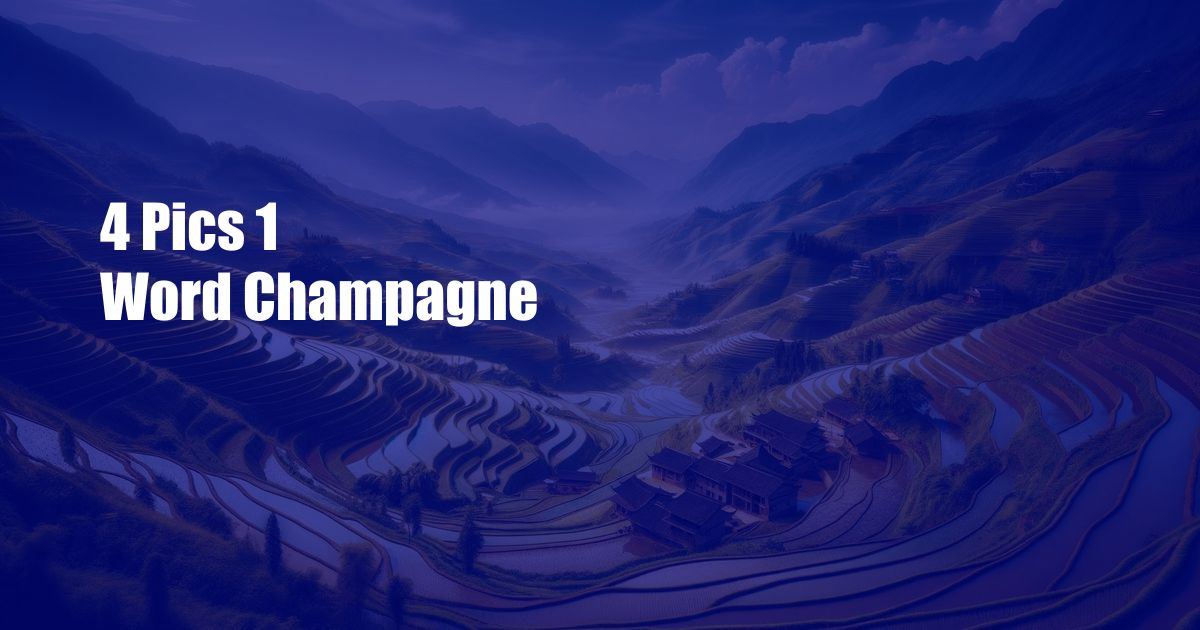
4 Pics 1 Word: Champagne – The Essence of Celebration
In the tapestry of life’s milestones, there are moments that call for a touch of effervescence, a celebration that echoes through the halls of memory. Amidst the multitude of celebratory beverages, champagne stands as a timeless icon, synonymous with joy, triumph, and the fulfillment of dreams.
Champagne, hailing from the hallowed vineyards of France’s Champagne region, is a sparkling wine that embodies the epitome of luxury and indulgence. Its enchanting bubbles, dancing gracefully within the flute, captivate the senses and evoke an air of festivity. Whether gracing the grandest of celebrations or adding a touch of elegance to intimate gatherings, champagne has become an indispensable element in the lexicon of celebration.
The History of Champagne
The origins of champagne can be traced back to the 17th century, when Benedictine monks in the Abbey of Hautvillers meticulously crafted a sparkling wine that would later captivate the world. Dom Pérignon, a cellar master at the abbey, is often credited with refining the champagne-making process, introducing techniques that would become the cornerstone of modern champagne production.
Over the centuries, champagne gained increasing popularity, becoming a favorite of royalty and the elite. In the 19th century, the invention of the champagne cork and the standardization of production methods allowed for the widespread distribution of this exquisite beverage, making it accessible to a broader audience.
The Production of Champagne
The production of champagne is a complex and time-consuming process that adheres to strict regulations set forth by the Champagne Appellation d’Origine Contrôlée (AOC). Only grapes grown within the designated Champagne region can be used, and the three primary varieties employed are Chardonnay, Pinot Noir, and Pinot Meunier.
Champagne is made using the traditional method known as méthode champenoise. After the initial fermentation, a secondary fermentation is induced within the bottle, resulting in the formation of carbon dioxide and the characteristic bubbles. The wine is then aged on its lees (spent yeast cells) for an extended period, which can range from a few years to several decades. This aging process imparts a rich, complex flavor profile upon the champagne.
The Styles of Champagne
The world of champagne offers a diverse range of styles to cater to various palates. From the crisp and refreshing brut to the lusciously sweet doux, there is a champagne to complement every taste and occasion.
Some of the most popular styles of champagne include:
- Brut: Dry and crisp, with a subtle sweetness.
- Extra Brut: Even drier than Brut, with a pronounced minerality.
- Demi-Sec: Slightly sweet, with a balance of acidity and sweetness.
- Doux: Sweet and rich, often served as a dessert wine.
Champagne in Modern Celebration
In contemporary society, champagne continues to play a pivotal role in major celebrations. From weddings and anniversaries to award ceremonies and sporting victories, the popping of a champagne cork signifies the commencement of a joyous occasion.
Champagne has also become a popular ingredient in cocktails, adding a touch of effervescence and sophistication to classic libations. Whether enjoyed neat or mixed with other spirits, champagne remains a beverage that exudes elegance and indulgence.
Tips for Enjoying Champagne
To fully appreciate the exquisite flavors and aromas of champagne, it is essential to serve and enjoy it properly. Here are some tips to elevate your champagne experience:
- Serve chilled: Champagne should be served at a temperature between 45-50°F (7-10°C) to preserve its delicate flavors.
- Use the correct glassware: A flute or tulip-shaped glass is ideal for champagne, as it allows the bubbles to rise and form a beautiful mousse.
- Pair with food: Champagne can be enjoyed as an aperitif or paired with a variety of dishes, such as seafood, poultry, and cheese.
- Savor the moment: Champagne is a special treat, so take your time to sip and savor its unique flavors and aromas.
FAQs about Champagne
Q: What is the difference between champagne and sparkling wine?
A: Champagne is a type of sparkling wine that is produced in the Champagne region of France using specific grapes and production methods. Other sparkling wines are made outside of the Champagne region and may use different grapes or إنتاج techniques.
Q: What is the best way to store champagne?
A: Champagne should be stored in a cool, dark place to prevent oxidation and preserve its flavors. It is best to store champagne horizontally to keep the cork moist and prevent it from drying out.
Q: Can champagne go bad?
A: Yes, champagne can go bad if it is not stored properly or if it is kept for too long. Signs of spoiled champagne include a loss of effervescence, a cloudy appearance, and a vinegary smell.
Conclusion
Champagne, the quintessential beverage of celebration, has captured our hearts and imaginations for centuries. Its delicate bubbles, exquisite flavors, and timeless elegance have made it an indispensable part of our most joyous moments. Whether enjoyed alone or shared with loved ones, champagne has the power to elevate any occasion and create memories that will last a lifetime.
So next time you have something to celebrate, reach for a glass of champagne and raise a toast to the good times. Because as Dom Pérignon himself is said to have proclaimed, “Come quickly, I am tasting stars!”
Cheers!
Are you interested in learning more about champagne? Let us know in the comments below!
 Azdikamal.com Trusted Information and Education News Media
Azdikamal.com Trusted Information and Education News Media